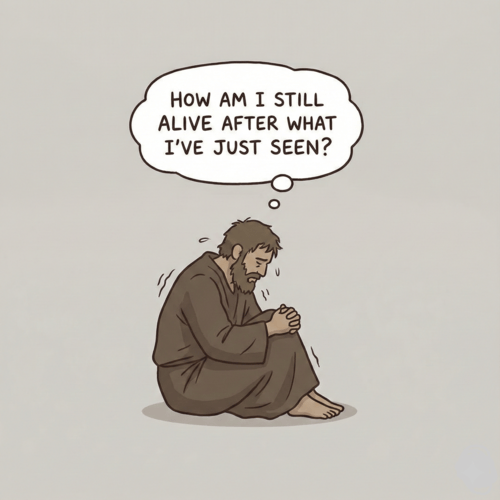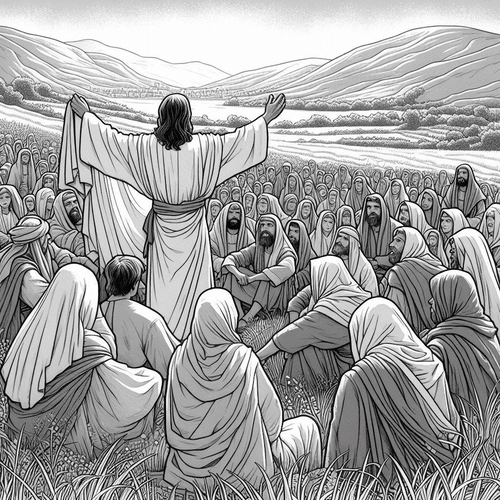1 John 5:6: How Do Water and Blood Reveal Jesus’ True Identity?
“This is he who came by water and blood—Jesus Christ; not by the water only but by the water and the blood. And the Spirit is the one who testifies, because the Spirit is the truth.” (1 John 5:6-7)
Some commentators suggest these are two of the most perplexing verses in Scripture. Yet within these few words lies a profound declaration about Jesus. The apostle John, writing near the end of the first century, wasn’t being cryptic for brevity’s sake. He was delivering a knockout punch to dangerous false teaching that threatened to undermine the gospel itself. Let’s see how.
WATER AND BLOOD: THE BATTLE FOR CHRIST’S TRUE IDENTITY
When John penned these words, the early church faced a growing threat from the Gnostics—a group who claimed special spiritual knowledge. These false teachers, particularly the followers of Cerinthius, taught the divine Christ had merely descended upon the human Jesus at His baptism, only to abandon Him before the crucifixion. In the Gnostic view, God can never truly become flesh or suffer death.
This isn’t merely an abstract theological dispute. If Jesus wasn’t truly human throughout His entire earthly ministry—including at His death—His sacrifice couldn’t atone for human sin. If He wasn’t truly divine, His death would have no infinite value. John’s urgent message was clear: get Jesus’ identity wrong, and you lose the gospel entirely.
The stakes couldn’t be higher. This is why John wrote, “Every spirit that confesses that Jesus Christ has come in the flesh is from God, and every spirit that does not confess Jesus is not from God” (1 John 4:2-3).
THE TESTIMONY OF WATER: CHRIST’S MESSIANIC INAUGURATION
Reformed theology consistently interprets the “by water” in 1 John 5:6 as referring to Christ’s baptism. This interpretation not only makes perfect sense within the narrative but also addresses the specific heresies John was combating.
At the Jordan River, something extraordinary happened. As Jesus emerged from the waters, the heavens opened, the Spirit descended like a dove, and the Father’s voice declared, “This is my beloved Son, with whom I am well pleased” (Matthew 3:17). This wasn’t merely a symbolic act—it was the public inauguration of Jesus’ messianic ministry, witnessed by crowds and authenticated by the Trinity.
John the Baptist’s testimony serves yet another vital purpose—in establishing Christ’s identity. John himself was the fulfillment of Isaiah’s prophecy about the voice crying in the wilderness (Isaiah 40:3). When John baptised Jesus, declaring “Behold, the Lamb of God, who takes away the sin of the world” (John 1:29), he was providing divinely appointed testimony to Christ’s identity. This wasn’t just human opinion—it was both prophetic fulfillment and divine revelation.
This baptismal testimony gives believers rock-solid certainty about Jesus’ identity. We’re not left to guess or depend on subjective feelings. God Himself provided external, objective witness through His chosen forerunner. John’s testimony was so crucial that Jesus later said, “You sent to John, and he has borne witness to the truth” (John 5:33).
THE TESTIMONY OF BLOOD: CHRIST’S ATONING DEATH
The “blood” in John’s testimony unmistakably points to the cross—the climactic moment when Christ poured out His life as an atoning sacrifice. This wasn’t a tragic accident or divine abandonment, as the Gnostics claimed. It was the predetermined purpose for which Christ came.
The blood of Christ accomplishes what no other sacrifice could. It provides propitiation—fully satisfying God’s just wrath against sin (1 John 2:2, 4:10). It demonstrates both God’s perfect love and His perfect justice in one magnificent act. As Paul declares, God presented Christ “as a propitiation by His blood, to be received by faith. This was to show God’s righteousness” (Romans 3:25).
The cross also reveals the depths of Christ’s humanity. Real blood was shed by a real human body. The divine Son didn’t slip away before the suffering—He endured it all, experiencing genuine human pain, anguish, and death. Yet this was no mere human death, for the blood shed was that of the God-man, giving it infinite value to atone for the sins of all who believe.
WHY BOTH WATER AND BLOOD MATTER: THE COMPLETE CHRIST
John’s emphasis on “not by the water only but by the water and the blood” delivers a decisive blow to the Gnostic heresy. The divine Christ didn’t just descend at baptism and depart before crucifixion. The same Jesus who was baptised was the one who died. The same one who began His public ministry in the Jordan finished it on Golgotha.
This “both/and” testimony reveals the complete scope of Christ’s redemptive work. The water points to the inauguration of His mission; the blood points to its completion. Together, they demonstrate Jesus remained fully God and fully man throughout his entire earthly ministry. (CHECK OUT OUR POST: Why do We Affirm Jesus is Fully God and Fully Man?)
THE TESTIMONY OF THE SPIRIT: DIVINE WITNESS AND CERTAINTY
But John doesn’t stop with water and blood. He adds the crucial third witness: “And the Spirit is the one who testifies, because the Spirit is the truth” (v. 7).
The Spirit’s testimony operates on multiple levels. Historically, the Spirit was present at both the baptism and the crucifixion, authenticating these events as part of God’s redemptive plan. The Spirit inspired the biblical writers to record accurate testimony about these events, ensuring we have reliable witnesses. But the Spirit also works internally, confirming the truth of this testimony to believers’ hearts.
This internal witness of the Spirit provides assurance that goes beyond mere intellectual agreement. As John explains, “Whoever believes in the Son of God has the testimony in himself” (1 John 5:10). The same Spirit who testified at Christ’s baptism and was present at his death now dwells within believers, bearing witness that Jesus is indeed the Christ, the Son of God.
THE UNIFIED TESTIMONY: THREE WITNESSES, ONE TRUTH
When water, blood, and Spirit unite in their testimony, they establish unshakeable certainty about Jesus’ identity. This follows the biblical principle requiring multiple witnesses to establish truth (Deuteronomy 19:15). But these aren’t merely human witnesses—they’re divine witnesses, carrying absolute authority.
Notice the beautiful Trinitarian harmony here. The Father speaks at the baptism, the Son is baptised and crucified, and the Spirit testifies to both. All three persons of the Trinity unite in revealing and confirming the identity of Jesus Christ.
WATER AND BLOOD: THE TESTIMONY THAT CHANGES EVERYTHING
John’s declaration in 1 John 5:6 may be brief, but it’s breathtaking in scope. Through the testimony of water, blood, and Spirit, we see Jesus revealed as the complete Christ—truly God and truly man, inaugurated in baptism and perfected through death, attested by the Trinity.
This isn’t merely academic theology. It’s the foundation of Christian assurance, the bedrock of evangelical confidence, and the fuel of Christian worship. When we grasp how thoroughly God has testified to his Son’s identity, faith becomes not a leap in the dark but a step into brilliant light.
This is the testimony that conquers the world (1 John 5:4). This is the Christ who saves completely all who come to God through him. This is the foundation that will never shake, no matter what storms of doubt or false teaching may arise.
WATER AND BLOOD: RELATED FAQs
What was John Calvin’s view about “the blood and water” 1 John 5:6? Calvin rejected allegorical interpretations, emphasising instead the water and blood refer to Christ’s baptism and death. He argued John was establishing Christ’s complete identity against those who would divide His person or minimise his humanity. Calvin noted that the Spirit’s testimony provides believers with internal assurance that confirms the external historical evidence. He particularly stressed that both water and blood were necessary to refute heretics who accepted Christ’s divinity at baptism but denied it at his death.
- How do contemporary Reformed scholars interpret the blood and water and spirit in this passage? Leading Reformed commentators such as John Stott, I Howard Marshall, and Robert Yarbrough maintain the traditional interpretation of water as baptism and blood as crucifixion. They emphasise John’s language is deliberately concrete and historical, not symbolic. These scholars argue the threefold witness (water, blood, Spirit) provides both objective historical evidence and subjective spiritual assurance. They consistently reject sacramental interpretations that would see the water and blood as referring to baptism and communion as ongoing church practices.
- Why don’t Reformed theologians accept the sacramental view that the water and blood refer to baptism and communion? The sacramental interpretation, while ancient, shifts focus from historical events to ongoing church practices. This doesn’t fit John’s argument against the Gnostics. John needed to establish what happened to the historical Jesus, not what happens in church ceremonies. The text’s emphasis on Jesus “coming by” water and blood points to specific past events, not repeated sacramental actions. Additionally, the phrase “not by water only” makes perfect sense if referring to baptism versus crucifixion, but creates awkward theology if referring to baptism versus communion.
- What about mystical interpretations that see deeper spiritual meanings in water and blood? While Scripture certainly contains rich symbolism, the context of 1 John 5:6 demands a historically grounded interpretation. John was combating specific false teachers who denied Christ’s full humanity throughout his earthly ministry. Abstract spiritual meanings, however beautiful, wouldn’t address the concrete heretical claims John was refuting. The Reformed approach maintains that while the events have profound theological significance, they must first be understood as actual historical occurrences. Mystical interpretations often end up undermining the very historical foundation that makes the theological meaning possible.
How does the liberal critical view handle this passage, and why is the Reformed interpretation stronger? Liberal scholars often minimise the supernatural elements, treating the Spirit’s testimony as merely human religious experience rather than divine witness. They may also question the historical reliability of the baptism and crucifixion accounts, seeing them as later theological constructions. The Reformed view is more compelling because it takes seriously both the historical claims and the theological significance John presents. It explains why John felt the need to combat specific heresies with concrete historical evidence. Liberal approaches often fail to account for the urgency and specificity of John’s argument, reducing a powerful apologetic text to vague spiritual sentiment.
WATER AND BLOOD: OUR RELATED POSTS
- Why do We Affirm Jesus is Fully God and Fully Man?
- The Virgin Birth: Why Do We Affirm It?
- Stop the Search: Jesus is The Promised Messiah
- Exploring the Historicity of Jesus: Facts and Evidence
- Five Eyewitnesses of the Resurrection: Their Compelling Testimony
- Types of Christ and His Cross in the Old Testament
Editor's Pick

The Throne-Room Vision: Who Did Isaiah See?
The scene is unforgettable: Isaiah stands in the temple, and suddenly the veil between heaven and earth tears open. He [...]

The Angel of the Lord: Can We Be Certain It Was Christ All Along?
Throughout the Old Testament, a mysterious figure appears: the Angel of the LORD. He speaks as God, bears God’s name, [...]
SUPPORT US:
Feel the Holy Spirit's gentle nudge to partner with us?
Donate Online:
Account Name: TRUTHS TO DIE FOR FOUNDATION
Account Number: 10243565459
Bank IFSC: IDFB0043391
Bank Name: IDFC FIRST BANK






